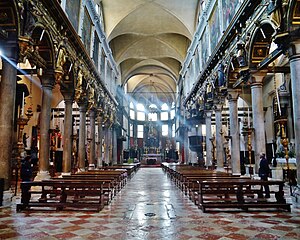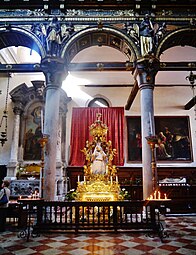Santa Maria dei Carmini
| Chiesa di Santa Maria dei Carmini | |
|---|---|
| Patronage : | Santa Maria del Carmine |
| Address: | Campo dei Carmini, Venice |
Coordinates: 45 ° 15 '21.6 " N , 12 ° 11' 31.3" O Santa Maria Carmini (also: SM del Carmine or SM del Carmelo ) is the name of a Roman Catholic Church and a former Karmeliter - convent in the Sestiere Dorsoduro in Venice . It is also known for short as " I Carmini " and is located near Campo di Santa Margherita, opposite the Scuola Grande dei Carmini , which is historically and institutionally connected to it.
history
According to Francesco Mondini, the first Carmelites came to Venice as early as 1125 at the time of Doge Domenico Michele. The church in its original form was built from 1286 under the title of Assumption of Mary . It was consecrated by the prior of the convent, Marco Morello, on April 6, 1348, in the presence of Bishop Domocense and six other bishops.

The church was rebuilt in the 16th century and changed in the spirit of the Renaissance . The facade, presbytery and side chapels were built between 1506 and 1514 by Sebastiano Mariani from Lugano . The decoration of the church dragged on into the early 18th century.
From 1300 came after church and monastery a charitable Tertiaries -Orden of Carmelites, popularly called " Pizzochere Carmini were known." In the beginning they lived in their private houses until a certain Luigi Vielmo gave them a house of their own called Santa Maria della Speranza (St. Mary of Hope) in 1498 .
Finally, in 1594, a brotherhood for both sexes was founded and the Scuola dei Carmini was built opposite the church. The brotherhood also has its own altar in the church , which, like the church, is consecrated to the Madonna del Carmine .
Numerous bishops emerged from the Venetian Carmelite Order and at the request of Pope Clement VII a reform of the order was worked out here.
The monastery was closed in 1810 and parts of the building were later used as a laundry.
description
Exterior
The simple but harmonious three-part Renaissance facade was built around 1500. It is made of red brick with white marble decor and is subtly structured by a few Tuscan pilasters and cornices . The marble portal is flanked by two arched windows to the right and left. The lunettes created Giovanni Buora. Above the gate you can see a Madonna and Child , and above the cornice, in the upper part of the facade, an octagonal oculus with a rose window. The round gable is decorated with a 16-point sun (or a star) with a rose in the center. The facade is crowned by five figures of saints, including depictions of the prophets Elias and Eliases by Tommaso Rues from the 17th century.
The side portal (to Campo di Santa Margherita) dates from the 14th century. It shows a relief bust of the Madonna and Child directly above the door and a marble medallion with two peacocks on the canopy outside .
The first campanile was in danger of collapsing in the 17th century and was renovated in 1676 by Giuseppe Sardi (1624–1699) in baroque forms. It is visible from afar. The original statue of the Madonna del Carmine on the spire was replaced by a new statue of Romano Vio after a lightning strike in 1982.
inner space
On the entrance wall is the grave monument of Jacopo Foscarini, who died in 1603, an admiral of the Venetian fleet , who lived in a palazzo opposite the church. The monument was created by Francesco Contin.
The elongated interior, typically Gothic in its proportions , shows some unusual features resulting from a mixture of different styles. The high central nave with a Gothic cross ribbed vault is flanked by two low side aisles, the round arches of which are supported by simple, archaic columns of the Byzantine - Romanesque type from the 14th century. The arcades themselves are clad with a baroque decoration made of carved, painted and partially gilded wood: above the columns figures of saints and prophets , above the arches angels.
The light falls from above through semicircular, two-part thermal bath windows that fit perfectly into the vaults of the ceiling. The wall surfaces of the upper storey , between the windows and the arcades, are decorated on both sides with a 24-part baroque painting cycle (in oil on canvas) with saints of the Carmelite Order , 12 images each on the left and right (17th-18th centuries ); among them are works by Sebastiano Mazzoni , Gregorio Lazzarini , (Giovanni Battista?) Lambranzi, Vincenzo da Canal and Gaspare Diziani .
The church is also rich in art treasures, of which only the most important can be mentioned.

Aisles
On the second altar on the right you can see the Adoration of the Baby Jesus by Cima da Conegliano from 1509, which is considered one of the most outstanding jewels of the church.
The Madonna del Carmelo with saints and souls in the purgatory is ascribed to Pace Pace (1595?); it is flanked on both sides by the sculptures of virginity and humility , masterpieces of sculpture by Antonio Corradini and Giuseppe Torretti . The vaulted ceiling was painted in 1708 by Sebastiano Ricci , who, unusual for his time, used a gold ground here .
The wood-carved miracle of the Madonna (1724) is by Francesco Bernadoni. The Elias in the desert created Gaspare Diziani .

The presentation of Jesus in the temple on the fourth altar on the right is an early work by Tintoretto from 1541–42.
The altarpiece of the Annunciation in the sacristy was painted by Jacopo Palma il Giovane .
The paintings in the left aisle deserve special attention: Padovanino's large-format mural The Holy Liberal had the Emperor acquitted two people condemned to death (1638), and the altarpieces, Education of the Virgin Mary by St. Anna by Flaminio Grapinelli (1738) and St. Alberto of Trapani by Pietro Liberi .
One of the absolute highlights of the church is (to the right of the side entrance) Lorenzo Lotto's Apotheosis of St. Nicholas , which he painted between 1527 and 1529.
Main altar and apse
The painted crucifix that hovers over the main altar is a work of Paolo Veneziano from the 14th century.
The walls of the presbytery , in front of the marble high altar, are also adorned with two murals each on the right and left. Below right the miraculous increase of bread and fish (or feeding the five thousand ) by Jacopo Palma il Giovane and above the paradise and St. Helena with the cross by Gaspare Diziani . Above left the Brazen Serpent is again by Diziani, below it is the Mannawunder by Marco Vicentino (son of Andrea Vicentino ).
Others
The beautiful cloister of the former monastery, which today belongs to a state art college , also deserves attention .
Picture gallery
Jacopo Tintoretto : Presentation of Jesus in the Temple , ca.1542
Pietro Liberi : St. Alberto of Trapani
literature
- Thorsten Droste: Venice (Art Guide), Dumont, Cologne, 1996, pp. 212–213
- Giandomenico Romanelli (Ed.): Venice - Art and Architecture , 2 volumes, Könemann, Cologne, 1997
- Flaminio Corner: Notes storiche delle chiese e monasteri di Venezia, e di Torcello tratte dalle chiese veneziane e torcellane , Stamperia del Seminario, Padua 1763.
- Ermolao Paoletti: Il fiore di Venezia ossia i quadri, i monumenti, le vedute ed i costumi , Tommaso Fontana editore, Venice 1839.
- Giuseppe Tassini: Edifici di Venezia. Distrutti o vòlti ad uso diverso da quello a cui furono in origine destinati , Reale Tipografia Giovanni Cecchini, Venice, 1885.
Web links
- Chiesa di Santa Maria dei Carmini on the Venice information website ( accessed April 14, 2020)
- Chiesa di Santa Maria del Carmine vulgo dei Carmini , on the website "Conoscere Venezia" (Italian; accessed April 14, 2020)
- Chiesa di Santa Maria dei Carmini on the website venice-tourism.com (Italian (also in English); accessed April 14, 2020)
Individual notes
- ↑ a b c d e f Chiesa di Santa Maria del Carmine vulgo dei Carmini , section “Storia della chiesa e del monastero”, on the website “Conoscere Venezia” (Italian; accessed April 14, 2020)
- ↑ Thorsten Droste: Venice (Art Guide), Dumont, Cologne, 1996, p. 212
- ↑ a b c d e f g h i j Chiesa di Santa Maria dei Carmini , on the website venice-tourism.com (Italian (also as English version); accessed on April 14, 2020)
- ↑ a b c d e f g h i j k l m n Chiesa di Santa Maria dei Carmini on the Venedigininformationen website ( accessed April 14, 2020)
- ↑ "Chiesa di Santa Maria del Carmine vulgo dei Carmini", section "Eventi più recenti", on the website "Conoscere Venezia" (Italian; accessed April 14, 2020)
- ↑ a b c d e f g h i "Chiesa di Santa Maria del Carmine vulgo dei Carmini", section "Visita della chiesa (1839)", on the website "Conoscere Venezia" (Italian; accessed April 14, 2020)
- ^ A b Thorsten Droste: Venice (Art Guide), Dumont, Cologne, 1996, p. 213
- ^ Augusto Gentili: Painting in Venice from 1450 to 1515 , in: Venice - Art and Architecture , Vol. 1, Könemann, Cologne, 1997, 254–309, here: pp. 299–303
- ↑ Paola Rossi: The Venetian sculpture in the 18th century , in: Venice - Art and Architecture , Vol. 2, Könemann, Cologne, 1997, 718–739, here: p. 728 and 730 f
- ↑ Stefania Mason: The Venetian Painting from the late 16th to 17th Century , in: Venice - Art and Architecture , Vol. 2, Könemann, Cologne, 1997, 524–574, here: pp. 542 and 545
- ↑ The dating is based on an inscription on the altar. Roberto D'Adda, Rodolfo Pallucchini: Lotto ( I classici dell'Arte ), Rizzoli / Skira / Corriere della Sera, Milan, 2004, p. 134
- ↑ Rosand erroneously and without argument gives 1523 as the year of origin. David Rosand: The Venetian Painting in the 16th Century , in: Venice - Art and Architecture , Vol. 1, Könemann, Cologne, 1997, 394–457, here: p. 403










